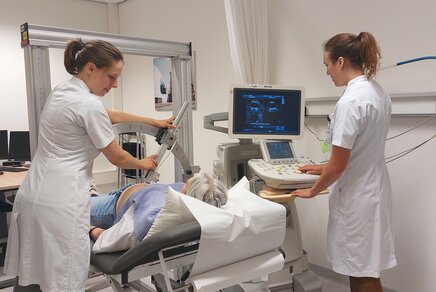Dynamic polymers as new biomaterials
Sandra Schoenmakers investigated the characteristics of supramolecular polymers in details, to select the best building blocks for future synthetic biomaterials.

To help in the growth of stem cells in the lab, scientist try already for years to create a material that mimics the environment surrounding cells. In her PhD research at the department of Chemical Engineering and Chemistry, Sandra Schoenmakers searched for the best building blocks for such synthetic biomaterials by looking at the properties of supramolecular polymers.
Supramolecular polymers are large structures that consists of small molecules. These are not held together by tight connections, but are linked by reversible interactions, like vanderwaals forces or hydrogen bonding. This results in dynamic materials similar to the materials found in nature.
However, creating synthetic biomaterials with the same level of functionality as nature is not as simple as mixing a few molecules in a vial. To select the best suitable building blocks and thus stimulating the development of a successful biomaterial, PhD-student Sandra Schoenmakers decided to take a step back. “By taking a closer look at the characteristics of supramolecular polymers we hopefully get a good fundamental understanding before increasing their complexity.”
Structure and dynamics
Supramolecular polymers are characterized by three properties which are constantly influencing each other, explains Schoenmakers. “Structure, dynamics and function. The interplay between structure and function is well-described in literature, but the dynamics are generally overlooked. I therefore focused on the interplay between structure and dynamics of supramolecular polymers.”
To investigate the structure of the supramolecular polymers in detail, Schoenmakers spend a lot time behind the microscope. With magnifications up to 25.000 times she looked at different supramolecular assemblies, based on the same core molecule: benzene-1,3,5-tricarboxamides (BTAs).
With surprising results. “We found that some of the supramolecular polymers, previously believed to consist of a single stack of molecules, are in fact two stacks of molecules that rotate around each other like a double helix.”
Fundamental understanding
To study the dynamics, Schoenmakers performed a different technique, hydrogen/deuterium exchange combined with mass spectrometry, revealing that some molecules within the polymers are more dynamic than others.
The fundamental research conducted by Schoenmakers provides a foundation for future research on the use of supramolecular polymers as biomaterials. “We discovered how we could create the desired supramolecular structure and dynamics, by intervening with the chemical structure or by mixing different building blocks."
"I used this knowledge to study with colleagues the first functional supramolecular polymers based on BTAs and their compatibility in biological environments. We now know that BTAs are suitable biomaterials, and with the acquired fundamental understanding we could create new synthetic biomaterials in the near future more focused.”
Sandra Schoenmakers defended her thesis ‘Supramolecular Polymers under the Magnifying Glass’ on Tuesday 30th of November. She was supervised by prof.dr. Bert Meijer and prof.dr.ir. Anja Palmans.
Media contact
More on Health



Latest news


![[Translate to English:] [Translate to English:]](https://assets.w3.tue.nl/w/fileadmin/_processed_/e/0/csm_BvOF%202019_1031_BHF%20license%20TUe%20ILI%20copy_8a50884392.jpg)